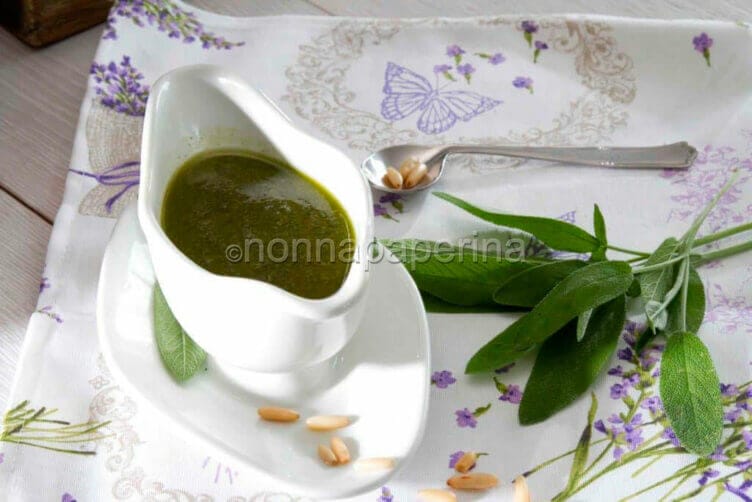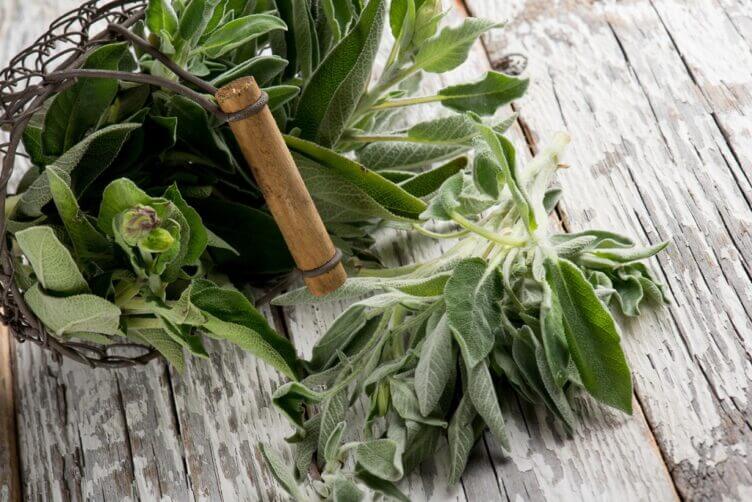
Sage pesto: a tasty condiment for many recipes

Sage pesto, a unique and tasty variant
Pesto is one of the most famous condiments in the world and the only true symbol of Mediterranean cuisine. Pesto is an ingredient that recalls aromas, flavours, and unforgettable moments spent preparing delights for those you love. The most famous of all is Genoese pesto.
It is excellent for seasoning pasta or even risottos. It can be paired with vegetable or fish main courses. For an aperitif, you can make delicious croquettes. In addition to being delicious and fragrant, sage pesto is a quick and simple sauce that is ideal for guests who are lactose or gluten intolerant, as well as those who are nickel intolerant.
These little details are all you need to make this sauce, taking into account those who live the experience of intolerances! These little details, as you will see shortly, make the sauce tasty. Homemade pesto is priceless!
Recipe sage pesto
Preparation sage pesto
- To prepare the sage pesto, start with the main ingredients. Clean and wash the sage leaves under running water.
- Then drain them and lay them out on a cloth to dry them well.
- Now peel the garlic and cut it into slices.
- Pour the sage leaves into a blender together with the pine nuts, the garlic clove, and a little salt.
- Turn on the blender and add the grated Parmesan and a few tablespoons of oil.
- Increase the speed to its highest setting until the mixture reaches the consistency you want. Depending on how creamy you want the pesto, you can adjust the amount of oil.
- Finally, you can add some walnut kernels, or almonds, instead of the pine nuts.
- The pesto is best used right away. If you use it for a pasta dish, soften it with two tablespoons of cooking water.
- The sage pesto should be kept in the refrigerator for two days after being put in a glass jar, sealed tightly, and covered with two teaspoons of oil. Freezing is not advised.
Ingredients sage pesto
- 50 gr. sage leaves
- 90/100 gr. extra virgin olive oil
- 30 gr. cedar pine nuts
- 40 gr. 36-month Parmigiano Reggiano
- a pinch of salt
- 1 clove of garlic (optional)
Long live sage, an antioxidant and anti-inflammatory plant.
Being one of the most popular aromatic plants in the kitchen, sage is used for more than just pesto. Its flavour can enhance any cuisine, and it’s a good idea to consider its many advantages when purchasing or cultivating it.
Which ones are the most important? Not to be overlooked is the presence of a considerable quantity of antioxidant and anti-inflammatory compounds. In the second case, it is wise to pay particular attention to rosmarinic acid, which is also found in rosemary and has the ability to precisely control the body’s inflammatory reaction.

Regarding antioxidant compounds, however, we must primarily mention the stem, a portion of the plant that can influence one of the most potent types of stress on our body’s cells.
Even though research on the topic is still in its early stages, it is important to keep in mind that sage extract has been shown in multiple trials to help prevent diabetes by blocking the liver’s release of glucose.
The benefits of Parmigiano Reggiano, an Italian excellence
Offering Parmigiano to people who are lactose intolerant is ideal. Why? For the straightforward reason that lactobacilli, which work by digesting all of the lactose in the curd, already form throughout the cheesemaking process.
Rich in vitamin B and iron, Parmigiano Reggiano is a great ally for bone health because of its high calcium level. It also boosts the body’s generation of lymphocytes and antibodies, which helps the immune system function more effectively.
How should pesto be preserved? The answer is less evident than you might think, and you can find it at the above URL. Additionally, although the recipe is straightforward, it has some unique characteristics, particularly in relation to the ingredients’ ability to hold up over time.
The contribution of cedar pine nuts in this sage pesto
Unlike basil pesto, the sage pesto recipe calls for cedar pine nuts instead of almonds or Mediterranean pine nuts. This decision was made in order to enhance the sauce’s aroma and add even more potent overtones while still paying due attention to the primary component. When it comes to flavour, cedar pine nuts are truly unbeatable and are also good for your health! In fact, their nutritional properties are numerous and interesting.
Because cedar pine nuts contain a lot of heart-healthy monounsaturated fats, they are a great source of energy. Additionally, they offer a healthy quantity of protein, which is beneficial for preserving muscle mass.
They are also rich in B vitamins, which are essential for energy metabolism, and vitamin E, which acts as an antioxidant, protecting cells from free radical damage. They are also abundant in minerals like iron, zinc, and magnesium, which are vital for healthy bones, the immune system, and brain function.
The Role of Garlic in the Sage Pesto
Garlic is also used in basil pesto, so it can also be used in the sage pesto. Although it’s not required, I suggest adding garlic because it gives the sauce more taste and makes it more lively.
It is true that garlic has a negative impact on breath if consumed in excessive doses, but on the other hand, it is good for cardiovascular health. The credit for this goes to the presence of sulphur compounds, such as allicin, which helps reduce blood pressure and LDL cholesterol levels (bad cholesterol). However, garlic improves blood circulation and has a vasodilatory effect.
This precious tuber is also rich in vitamin C and B6, which support the immune system and energy metabolism. It also has antibacterial, antiviral, and anti-inflammatory properties, as well as being a good source of selenium, a mineral essential for thyroid function.
If you really don’t like garlic, you can use shallots or leeks. Shallots offer a less pungent but aromatic touch, while leeks are lighter and give a softer taste.
Sage pesto FAQs
How does sage taste?
Sage has a strong and aromatic flavor, with slightly bitter and rustic notes. Its taste can be described as warm and pungent, with a light hint of mint and rosemary. Sage is one of the most intense aromatic herbs, which is why it is used in small quantities to enrich dishes.
What is sage good for?
Sage has a lot of advantageous qualities. It is well-known for its antioxidant, anti-inflammatory, and digestive qualities. It is frequently used to treat mouth irritation, sore throats, and digestive issues. Additionally, it has phenolic acids and flavonoids, which boost immunity and enhance circulation.
What can you do with sage?
Meat, seafood, soups, sauces, and side dishes are just a few of the foods that can be flavoured with sage. It can be used to make herbal teas, flavouring oils, or as a condiment for roasted vegetables and roasts. It is also used to go with butter-based foods like ravioli with butter and sage. Last but not least, sage makes a great pesto.
What is sage pesto used for?
Sage pesto is a tasty sauce that can be used to season pasta, rice, or bruschetta. It is also an excellent condiment for seasoning meat, fish, or grilled vegetables. Sage gives pesto an aromatic and slightly bitter taste, creating an interesting variation on the classic basil pesto.
Do we have any pesto recipes? Of course we do!
COULD IT BE INTERESTING FOR YOU

Chicken Yassa, a spicy and tasty Senegalese dish
Discovering Yassa chicken Yassa is a Senegalese dish made with chicken and rice, a complete dish that is appreciated for the variety of flavours and the massive use of spices. The recipe is...

Red basil and green basil, their differences and...
The main properties of basil Red basil properties. The properties of green basil and red basil are similar, but the latter has an extra edge. Both are rich in calcium, potassium, and omega-3 fatty...

All about thyme, the aromatic herb that tastes...
Everything from the proper foundation to the components that provide value Tartlets with carrot, celeriac, and thyme can be prepared in around 40 minutes (20 minutes of prep + 20 minutes of...
























